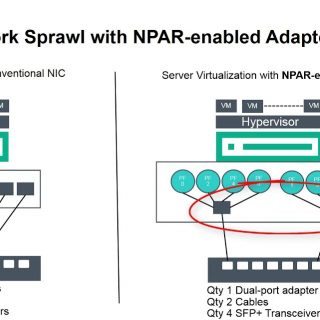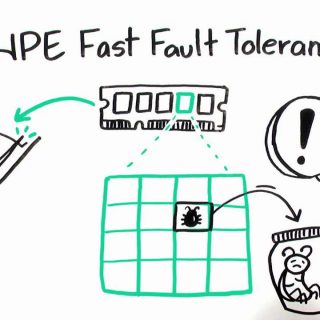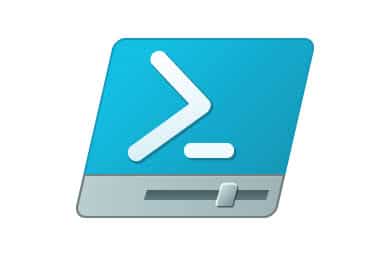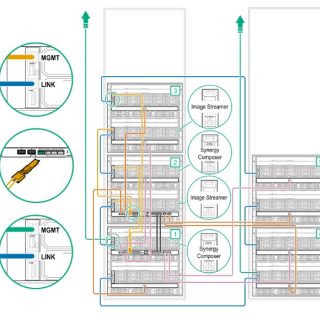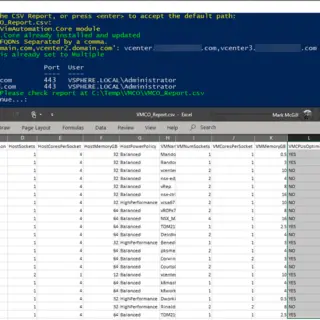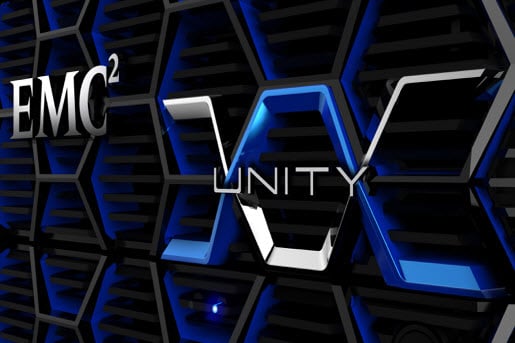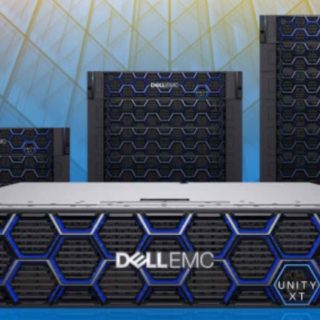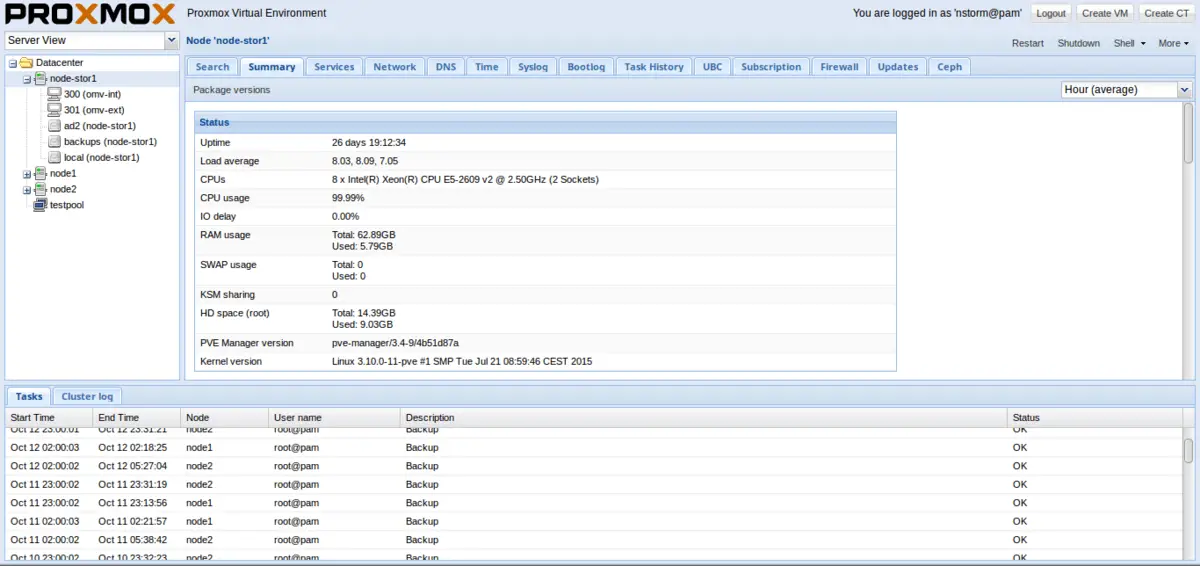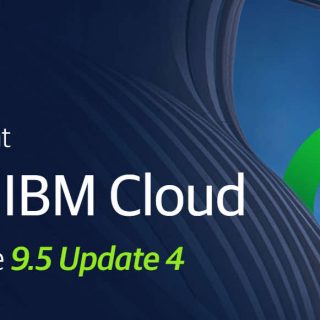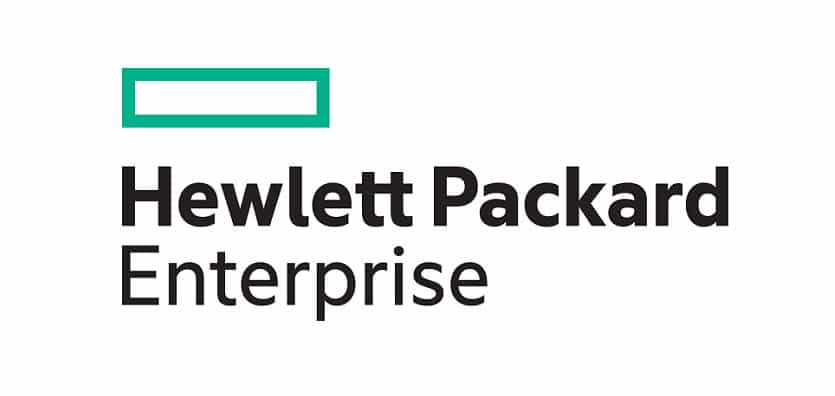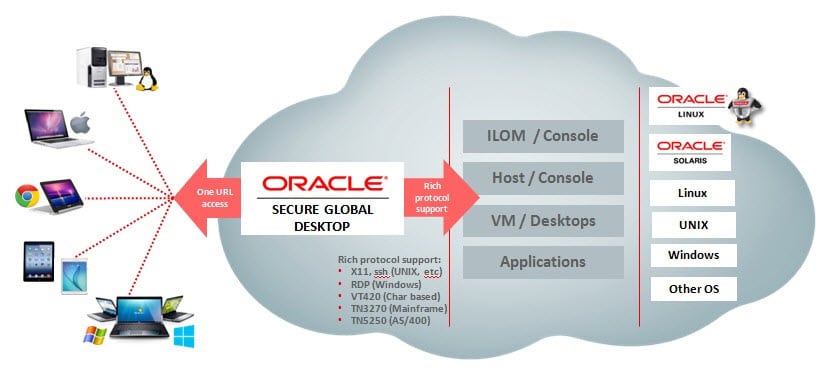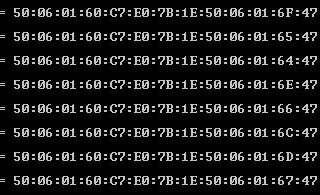Davoud Teimouri - Virtualization and Data Center Blog

Data Center design is changing year by year, before virtualization all servers was physical and data centers were full of devices and cables. Virtualization helped to make data centers smaller and consolidate different workloads in same hardware. Hardware technologies are also helping to achieve this goal. Network Partitioning (NPAR) is one of hardware technologies which helping to reduce cabling, switch devices and use all I/O capacity in data centers. What’s Network Partitioning (NPAR)? NPAR is an operating system and switch agnostic technology that allows customers to reduce the number of I/O adapters required to support different application workloads. Traditional best practices require separate LAN or SAN connections for different aspects of application workloads. Converged Network Adapters already support widely used SAN protocols like Fibre Channel over Ethernet (FCoE) and iSCSI, administrators can already reduce the number of adapters needed for separate protocols, including separate Fibre Channel and Ethernet adapters. With NPAR, these adapters can now partition their network bandwidth further into multiple virtual connections, making one dual-port adapter appear as eight adapters to the operating system for use by the applications. This greatly simplifies the physical connectivity to the server, reduces implementation time, and lowers the acquisition cost of the...

Memory failure is one of reasons that can be cause of server crash and impact on service availability and performance. Think about a service which including multiple servers, server could be crashed cause of single memory module failure or uncorrectable memory error. Regarding to preventing memory impact of memory errors on services, HPE provides RAS technologies. RAS (reliability, availability, and serviceability) technologies are including: In this post, we’ll compare HPE Fast Fault Tolerance and HPE Advanced ECC Support. Before comparison, let’s find that why we need to memory RAS? Why Memory RAS is needed? Server uptime is still one of the most critical aspects of data center maintenance. Unfortunately, servers can run into trouble from time to time due to software issues, power outages, or memory errors. The three major categories of memory errors we track and manage include correctable errors, uncorrectable errors, and recoverable errors. The determination of which errors are correctable and uncorrectable is completely dependent on the capability of the memory controller. Correctable Errors Correctable errors are, by definition, errors that can be detected and corrected by the chipset. Correctable errors are generally single-bit errors. All HPE servers are capable of detecting and correcting single-bit errors and...

Last post was about configuring HPE smart array and create logical drives on HPE G10 servers by HPE Scripting Tools. This post is about configuring HPE G10 via PowerShell by using HPE BIOS cmdlets. As I have mentioned in the last post, there are also cmdltes available for Smart Array, iLO and OA which helping administrators to configure and deploy servers faster than regular ways and without no additional cost. In order to configure HPE servers by script, you need to download and install HPE Scripting Tools: Scripting Tools for Windows Sample BIOS Script The below script is a sample for configuring HPE DL580 G10: The above script needs same credential on multiple servers if you want to applying configurations on multiple servers at same time. Also don’t run script on server that server has production server, it has been created for first deployment. Replace “iLO IP 1” and others with your servers’ iLO IP addresses. Further Reading Why Device Bay IP Doesn’t Change in HPE BladeSystem? [Script]: Enable/Disable vMotion on VMKernel Ports via PowerCLI Configure NTP on iLO via HPE Scripting Tools How to Create Logical Drive on HPE DL580 G10

I have published some posts about HPE Scripting Tools for PowerShell to automating physical server preparation and deployment services. The tools helping administrators to deploying services on HPE servers faster than normal ways, also there is no additional costs, just buy a PowerShell book! The scripting tools provides PowerShell cmdlets for configuring BIOS, iLO, OA and Smart Array. The tools are available for download as free tools on HPE website. Scripting Tools for Windows The smart array cmdlets are compatible with HPE Generation 10 and not all smart array adapters. Read the user guide document to find list of compatible smart array adapters. The tools will help to configure smart array adapters on multiple servers very faster than normal ways or other automation tools. Of course, the tools is not comparable with HPE OneView. Sample PowerShell Script to Create Logical Drive with 2 Drive The below sample will create two logical drives from 4 drives on multiple servers: Same administrator account will be required on the servers and you can change “iLO IP” with your iLO IP addresses. Logical drives will be made as RAID 1. The script has been tested on HPE DL580 G10. You need to install HPE...

HPE Synergy is a next‐generation data center architectural option, Composable Infrastructure embraces and extends key concepts and traits from the architectures that have come before it, including converged and hyperconverged systems. I don’t know when but seems that HPE will replace HPE Blade System with HPE Synergy in future. Those who worked with HPE Blade System, will confuse about HPE Synergy configuration. Configuration is very different with Blade System at all. Cabling is one of biggest challenges with HPE Synergy. There is many management connection which should connect to the correct ports. Because HPE Synergy is a composable infrastructure so there are some options to have multi-frame configuration which allows companies to resource expansion and service expansion easily. I recommend that design cabling according to service requirements before initializing new hardware. There are some sample configurations for interconnect connections, stack connections, Image Streamer connections and management: Cabling interconnect modules in a single frame with redundancy Cabling master and satellite interconnect modules in multiple frames (non-redundant) Cabling master and satellite interconnect modules in multiple frames (with redundancy) Cabling a single-frame management ring Cabling a multiframe management ring Cabling a single-frame management ring with HPE Synergy Image Streamer Cabling a three-frame management...

Virtual Machine Compute Optimizer is a new fling which has been published on VMware Labs. The Virtual Machine Computer Optimizer (VMCO) is a Powershell script that uses the PowerCLI module to capture information about the hosts and VMS running in your vSphere environment, and reports back on whether the VMs are configured optimally based on the Host CPU and memory. It will flag a VM as “YES” if it is optimized and “NO” if it is not. For non-optimized VMs, a recommendation is made that will keep the same number of vCPUs currently configured, with the optimal number of virtual cores and sockets. Requirements In order to run the Virtual Machine Compute Optimizer, you will need the following: Windows 7/Server 2008 or above Powershell v5 or higher The PowerCLI Module installed, or access to the internet. The VMCO will attempt to install the module if it is not already, and give you an option to upgrade if it is out of date. A user account with Read-Only rights assigned at the vCenter level with ‘Propogate to children’enabled. These rights will be needed on each vCenter that will be analyzed. Further Reading VMware Tools Client – Interact with a VM without...

EMC has released Operating Environment for EMC Unity Platform. The new version is a major version and includes some new features. Also some problems have been fixed in this version. EMC has been added support for Dell EMC Unity XT (Newest Unity family’s member). So this release is minimum version and basic requirement for Unity XT. Let’s review the new features which added to this new version. What’s New? New Drive Support With this release, all Unity Hybrid models now support 12 TB nearline SAS drives. Automatic Clean-up of Resolved Health Alerts In previous releases, the Alerts page showed all alerts for the system. With this release, the default view will show only active alerts that have not yet been resolved. Enhanced Data Reduction The data reduction feature has been enhanced to: Add support for NFS and VMFS datastores. Deduplicate uncompressed blocks for new writes or overwrites. Existing data does not change. Support the following models: Dynamic or Traditional pools in Unity 380F, 480F, 680F, and 880F systems Dynamic pools in Unity All-Flash 450F, 550F, and 650F systems All-Flash pools in Unity Hybrid 380, 480, 680, and 880 systems Drive Firmware Update After OE Upgrade After you successfully upgrade the...
Simplify the path to IT transformation and unlock the full potential of your data capital with the new Dell EMC Unity XT
storage arrays that feature up to 2X more IOPS, more memory, and up to 50% more drives than previous Dell EMC
Unity models. These All-Flash and Hybrid storage systems with dual-active controller architecture and enterprise-class
features are designed for performance, optimized for efficiency with up to 5:1 data reduction, and built to simplify your
multi-cloud journey.
Proxmox Server Solutions GmbH, developer of the open-source virtualization management platform Proxmox VE, today released its major version Proxmox VE 6.0. The comprehensive solution, designed to deploy an open-source software-defined data center (SDDC), is based on Debian 10.0 Buster. It includes updates to the latest versions of the leading open-source technologies for virtual environments like a 5.0 Linux kernel (based on Ubuntu 19.04 “Disco Dingo”), QEMU 4.0.0, LXC 3.1.0, Ceph 14.2 (Nautilus), ZFS 0.8.1, and Corosync 3.0.2. Proxmox VE 6.0 delivers several new major features, enhancements, and bug fixes.
Veeam has release Veeam Backup and Replication 9.5 Update 4b to resolve issues that reported after release update 4 and 4a. This release is a rollup update, also it’s including some new features and enhancements. Update 4b is a cumulative update, meaning it includes all enhancements delivered as a part of Update 4a.
Having problems finding a single scripting tool that provides management automation among the server components? Being challenged with many tools, remote management vulnerabilities and scripting limitation? Hewlett Packard Enterprise offers you a single scripting tool called RESTful Interface Tool designed for HPE ProLiant Gen9 & Gen10 Servers with flexible and simpler scripting server automation at scale for rapid deployments to help cut time substantially.
Oracle Secure Global Desktop (SGD) is a web-based solution that allows users to remotely access data and applications in a data center or the cloud. It provides administrators with a single pane of glass to manage secure access to resources with a completely air-gapped, highly secure connection between the client and the data and applications accessed, allowing complete control of which user can access which application and the server it runs on, all through a convenient web interface.
RAMBleed is a side-channel attack that enables an attacker to read out physical memory belonging to other processes. The implications of violating arbitrary privilege boundaries are numerous, and vary in severity based on the other software running on the target machine. As an example, in our paper we demonstrate an attack against OpenSSH in which we use RAMBleed to leak a 2048 bit RSA key. However, RAMBleed can be used for reading other data as well.
The redhat-upgrade-tool provides a way to upgrade Red Hat Enterprise Linux 6 systems to Red Hat Enterprise Linux 7. The redhat-upgrade-tool command is a program to collect the information for upgrade and prepare the environment. It includes downloading kernel, and initial ram image, and packages.
Knowing devices WWN is necessary to define aliases during zone creation in SAN environments on SAN switches, you need to storage FC ports WWN as targets in each zone. So where you can find device’s FC ports information?
